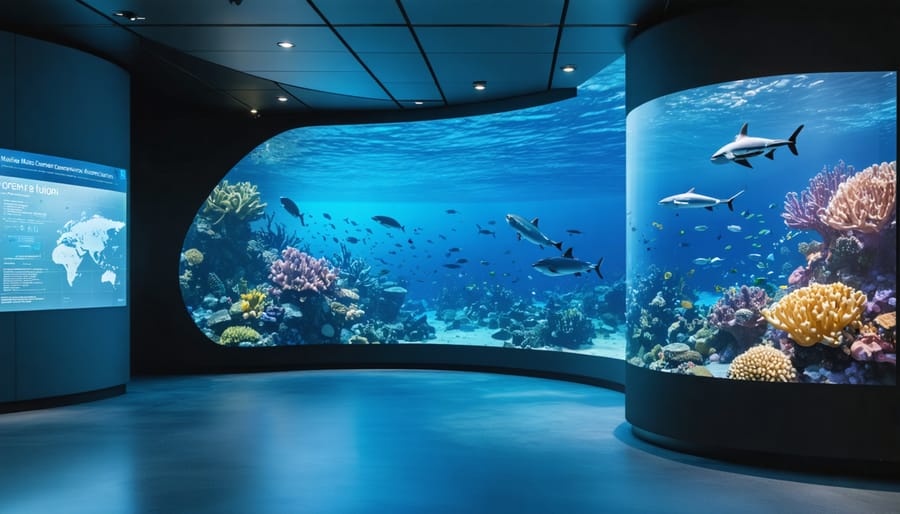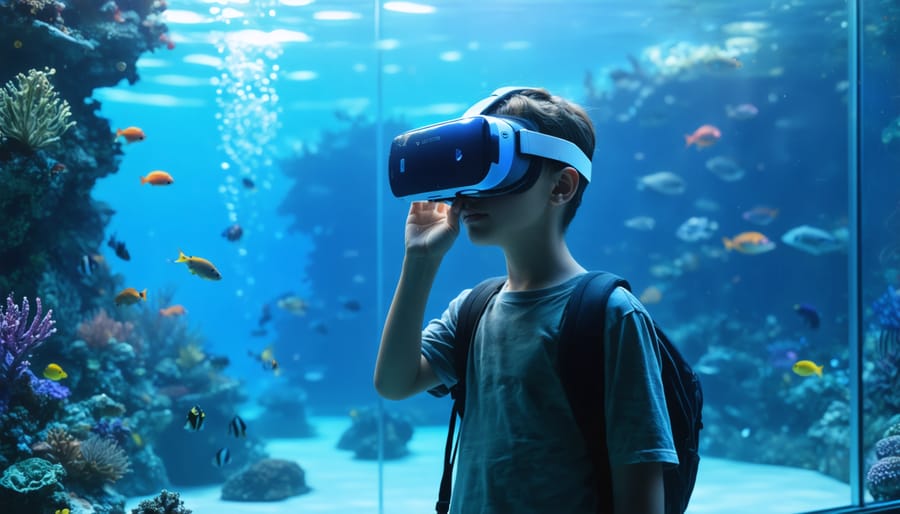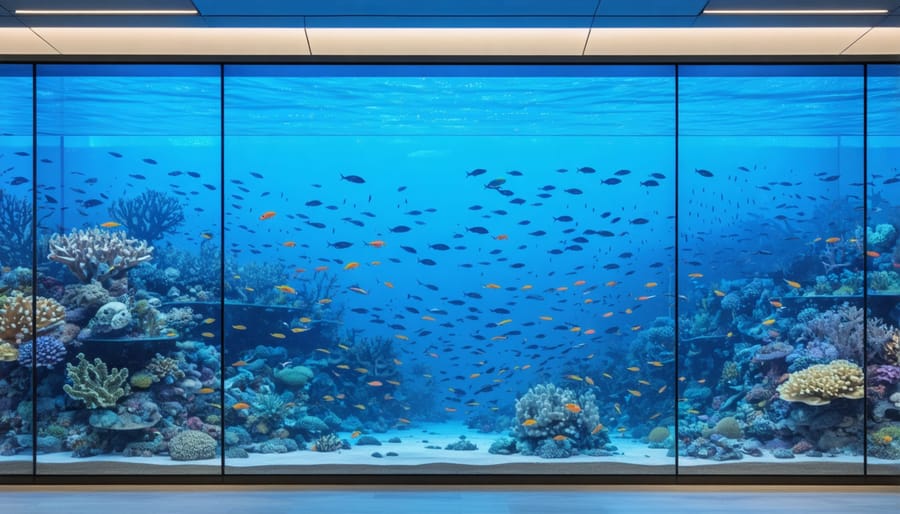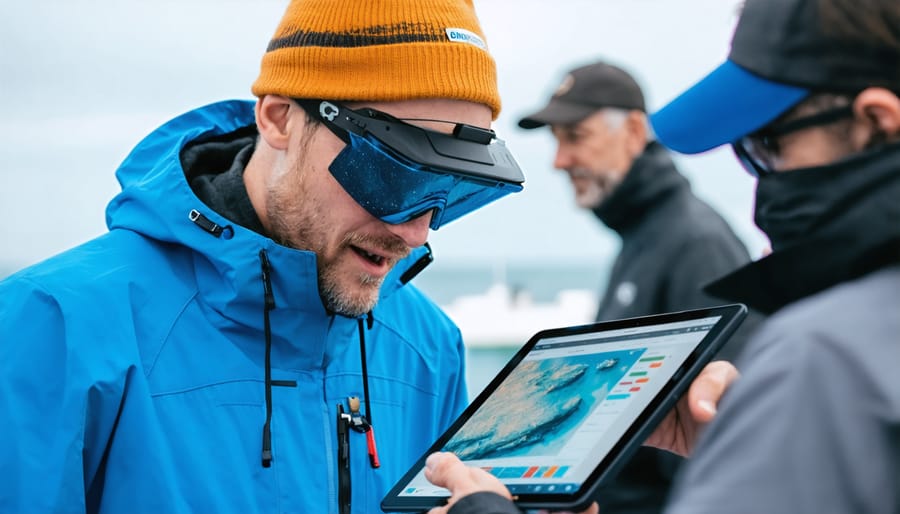
At the intersection of cutting-edge technology in marine science and ocean conservation, modern marine conservation and technology facilities are revolutionizing our approach to protecting marine ecosystems. These state-of-the-art centers combine advanced monitoring systems, artificial intelligence, and innovative research methods to address critical challenges facing our oceans. From deep-sea mapping using autonomous underwater vehicles to real-time coral reef health monitoring through IoT sensors, these facilities serve as crucial hubs where scientific discovery meets practical conservation action.
The integration of virtual reality simulations, machine learning algorithms, and sophisticated data analytics enables researchers to track marine populations, predict environmental changes, and develop targeted conservation strategies with unprecedented precision. These technological advances not only enhance our understanding of marine ecosystems but also create powerful educational tools that bridge the gap between scientific research and public engagement.
As our oceans face mounting pressures from climate change, pollution, and overexploitation, these facilities stand as beacons of hope, demonstrating how human ingenuity and technological innovation can work together to safeguard our marine heritage for future generations.
The Evolution of Marine Conservation Facilities
From Traditional Aquariums to Interactive Learning Hubs
Modern marine facilities have evolved dramatically from their early days as simple aquariums with fish tanks and basic displays. Today’s facilities integrate cutting-edge technology to create immersive learning environments that actively engage visitors in marine conservation efforts. Interactive touch screens allow visitors to explore detailed marine ecosystems, while augmented reality installations bring ocean environments to life, enabling guests to virtually swim alongside marine species.
Digital tracking systems now provide real-time updates on marine animal behaviors and migration patterns, offering visitors unprecedented insights into marine life. Many facilities have incorporated citizen science programs, where visitors can contribute to ongoing research projects through mobile apps and interactive data collection stations.
These transformation efforts extend beyond physical spaces. Virtual reality experiences transport visitors to remote coral reefs and deep-sea environments, while live streaming cameras connect them with marine scientists conducting field research. Educational programs now feature hands-on laboratories where students can analyze water quality, study microplastics, and participate in coral restoration projects.
This evolution reflects a broader shift in marine education, emphasizing active participation and personal connection to ocean conservation rather than passive observation.
Digital Integration in Modern Marine Centers
Modern marine centers are embracing digital transformation to enhance their conservation efforts and research capabilities. Advanced monitoring systems now track marine life in real-time, utilizing underwater sensors and GPS tracking devices to collect vital data about species behavior and ecosystem health. These innovations allow scientists to make informed decisions about conservation strategies while minimizing human intervention in delicate marine environments.
Interactive displays and augmented reality installations have revolutionized visitor education, offering immersive experiences that bring ocean ecosystems to life. Visitors can now explore virtual coral reefs, track migrating whales, and understand complex marine relationships through intuitive digital interfaces. This technology bridges the gap between scientific research and public understanding, making marine conservation more accessible to everyone.
Cloud-based data management systems enable collaboration between marine centers worldwide, creating a global network of shared knowledge and resources. Scientists can instantly access and analyze data from multiple locations, leading to more comprehensive research outcomes. Additionally, artificial intelligence and machine learning algorithms help process vast amounts of environmental data, identifying patterns and trends that might otherwise go unnoticed.
These digital tools not only enhance research capabilities but also improve facility operations, from water quality management to energy efficiency, creating more sustainable marine conservation centers.
Core Technologies Enhancing Marine Education
Virtual Reality Ocean Experiences
The facility’s Virtual Reality Ocean Experiences center transforms marine education through cutting-edge immersive technology. Visitors don specialized VR headsets to dive into stunningly realistic underwater environments, experiencing marine ecosystems firsthand without getting wet. These virtual experiences range from exploring vibrant coral reefs teeming with tropical fish to witnessing the majesty of whale migrations in deep ocean waters.
Each VR session is carefully designed to combine entertainment with educational value. Participants can interact with marine life, observe behaviors in their natural habitat, and learn about species relationships within the ecosystem. The technology allows users to safely encounter endangered species and witness rarely-seen marine phenomena, creating memorable learning experiences that foster a deeper connection to ocean conservation.
Educational programs utilize these VR experiences to illustrate the impacts of climate change, overfishing, and pollution on marine environments. Students can witness before-and-after scenarios of coral bleaching, observe the effects of plastic pollution, and understand how human activities influence ocean health. This visceral experience often proves more impactful than traditional learning methods.
The facility regularly updates its VR content with new scenarios based on current research and conservation challenges. Marine biologists and educators collaborate to ensure scientific accuracy while maintaining engagement. Special programs allow participants to join virtual research expeditions, experiencing the work of marine scientists firsthand and inspiring the next generation of ocean conservationists.

Interactive Touch Screens and Digital Exhibits
The facility’s interactive touch screens and digital exhibits represent the cutting edge of marine education technology, offering visitors an immersive journey into ocean ecosystems. These installations combine stunning visuals with marine artificial intelligence to create dynamic, responsive learning experiences that adapt to each user’s interests and knowledge level.
Visitors can explore detailed 3D models of marine species, manipulating them with simple touch gestures to study their anatomy and behavior patterns. The “Ocean Explorer” interface allows users to dive into different marine habitats, from coral reefs to deep-sea trenches, with real-time data feeds showing current ocean conditions and species distributions.
A crowd favorite is the “Conservation Impact” display, where touchscreen simulations demonstrate how human activities affect marine ecosystems. Users can adjust variables like pollution levels or fishing practices to see immediate and long-term environmental impacts, making complex ecological concepts accessible and memorable.
The “Marine Citizen Science Portal” enables visitors to contribute to ongoing research by identifying species in recent underwater footage or reporting marine debris sightings. This interactive feature connects visitors directly to conservation efforts, transforming passive learning into active participation in marine research and protection.
These digital exhibits are regularly updated with new content from field researchers and conservation projects, ensuring that visitors always have access to the latest marine science discoveries and conservation initiatives.

Live Streaming and Remote Learning Capabilities
The facility’s state-of-the-art live streaming infrastructure brings the ocean directly to classrooms and researchers worldwide. High-definition underwater cameras, strategically placed throughout our marine habitats and local reef systems, broadcast real-time footage 24/7. These feeds enable students and scientists to observe marine life in their natural environment without physical presence or disruption.
Our remote learning platform integrates these live streams with interactive educational tools, allowing participants to engage in virtual field trips and citizen science projects. Students can participate in guided sessions where marine biologists explain behaviors and phenomena as they occur, making marine science accessible to anyone with an internet connection.
“The ability to connect students from landlocked areas with our ocean ecosystems has been transformative,” shares Dr. Sarah Chen, our head of educational outreach. “We’ve had classrooms from Montana to Mongolia participating in our coral monitoring programs.”
The facility also maintains a digital archive of recorded observations, creating a valuable resource for researchers studying marine behavior patterns and ecosystem changes over time. Remote sensors provide real-time data on water quality, temperature, and marine wildlife movements, which is immediately accessible through our online dashboard.
For professional development, we offer virtual workshops and certification courses, enabling marine conservation practitioners worldwide to enhance their skills without the need for travel. This technology has proven particularly valuable during global events that restrict physical movement, ensuring continuous education and research collaboration.
Research Integration and Public Education
Real-time Data Collection and Display
The facility’s cutting-edge marine monitoring systems transform complex oceanic data into engaging visual displays that captivate visitors while advancing scientific research. High-resolution sensors deployed throughout local marine ecosystems continuously collect data on water quality, temperature variations, species movement patterns, and habitat health.
Interactive touchscreen displays throughout the facility present this information in real-time, allowing visitors to explore current ocean conditions and marine life activities. A centerpiece visualization wall uses advanced mapping technology to show the movements of tagged marine species, helping researchers track migration patterns while giving visitors an unprecedented view of marine life behavior.
The facility’s data collection network includes underwater cameras, hydrophones for recording marine mammal communications, and environmental DNA sensors that detect species presence through water samples. This information feeds into both research databases and public education displays, creating a bridge between scientific monitoring and public engagement.
Dr. Sarah Chen, the facility’s lead researcher, explains, “We’ve designed our real-time displays to tell stories that connect people with marine life. When visitors see a pod of dolphins moving through local waters or watch coral polyps feeding at night, they develop a deeper understanding of marine ecosystems and why they need protection.”
The collected data also supports global conservation efforts by contributing to international marine research databases and early warning systems for environmental changes.
Citizen Science Initiatives
Our facility champions several innovative citizen science programs that harness technology to engage the public in meaningful marine research. Through our mobile app-based initiatives, volunteers contribute valuable data by photographing and documenting marine species they encounter along coastlines. This information feeds directly into our comprehensive database, helping scientists track population changes and species distribution patterns.
The “Digital Ocean Observers” program equips participants with underwater cameras and basic training in marine species identification. Volunteers can upload their observations in real-time, creating a dynamic map of marine biodiversity that researchers use to monitor ecosystem health. The program has already documented over 50,000 species observations, leading to the discovery of previously unknown population patterns of several threatened species.
Our “Smart Buoy Network” allows citizen scientists to adopt and monitor water quality sensors, contributing to a growing database of ocean health indicators. Participants access real-time data through their smartphones and help identify concerning trends in temperature, pH levels, and pollution indicators.
Students and educators particularly benefit from our “Virtual Marine Lab” program, where they can participate in ongoing research projects through remote-controlled underwater vehicles and live video feeds. This hands-on experience has inspired many young participants to pursue careers in marine science and conservation.
These initiatives demonstrate how technology can bridge the gap between professional researchers and passionate citizens, creating a collaborative approach to marine conservation that benefits both science and public education.

Future Innovations on the Horizon
As we look toward the future of marine conservation, groundbreaking ocean innovations are poised to revolutionize how we study, protect, and educate others about our marine ecosystems. Advanced artificial intelligence systems are being developed to process vast amounts of underwater data in real-time, enabling researchers to track marine species movements and behavioral patterns with unprecedented accuracy.
Virtual and augmented reality technologies are evolving to create immersive educational experiences that will transport students directly into underwater environments from their classrooms. These systems will allow learners to interact with virtual marine life, observe ecosystem dynamics, and understand complex oceanic processes through hands-on digital experiences.
Autonomous underwater vehicles (AUVs) equipped with sophisticated sensors are becoming more advanced, promising to reach previously unexplored ocean depths. These robots will work alongside marine biologists to collect samples, monitor water quality, and document marine biodiversity in ways that were impossible before.
Biotechnology is opening new frontiers in marine conservation, with researchers developing innovative methods for coral reef restoration and species preservation. DNA sequencing technologies are becoming more portable and affordable, enabling rapid species identification and population health assessments in the field.
Environmental DNA (eDNA) sampling techniques are being refined to provide non-invasive monitoring of marine ecosystems, while machine learning algorithms are improving our ability to predict and respond to environmental threats. These developments will enhance our understanding of marine ecosystems and help us protect them more effectively.
The integration of blockchain technology is also emerging as a powerful tool for tracking sustainable fishing practices and maintaining transparency in marine resource management. This will help ensure the effectiveness of conservation efforts and promote responsible seafood consumption.
As these technologies continue to evolve, they will create new opportunities for citizen science participation, allowing the public to contribute meaningfully to marine conservation efforts while learning about ocean ecosystems in engaging and interactive ways.
As we’ve explored throughout this article, technology plays an instrumental role in revolutionizing marine conservation education and research. From virtual reality diving experiences to real-time ocean monitoring systems, these innovative tools are breaking down barriers and creating unprecedented opportunities for learning and engagement with marine ecosystems.
The integration of advanced technology in marine conservation facilities has transformed how we understand and protect our oceans. These developments not only enhance research capabilities but also make marine science more accessible to students, educators, and the public. Through interactive displays, digital mapping tools, and citizen science platforms, people from all walks of life can now actively participate in marine conservation efforts.
The future of marine conservation relies heavily on this synthesis of technology and education. As these facilities continue to evolve, they create powerful platforms for raising awareness about ocean conservation challenges and inspiring the next generation of marine scientists and conservationists.
You can make a difference today by getting involved with your local marine conservation facility, participating in citizen science projects, or supporting technological innovations in ocean research. Whether you’re a student, educator, or simply someone passionate about protecting our oceans, there’s a place for you in this growing community of ocean advocates.
Together, through the thoughtful application of technology and collective action, we can work toward a future where our marine ecosystems thrive for generations to come.
jessica
Ava Singh is an environmental writer and marine sustainability advocate with a deep commitment to protecting the world's oceans and coastal communities. With a background in environmental policy and a passion for storytelling, Ava brings complex topics to life through clear, engaging content that educates and empowers readers. At the Marine Biodiversity & Sustainability Learning Center, Ava focuses on sharing impactful stories about community engagement, policy innovations, and conservation strategies. Her writing bridges the gap between science and the public, encouraging people to take part in preserving marine biodiversity. When she’s not writing, Ava collaborates with local initiatives to promote eco-conscious living and sustainable development, ensuring her work makes a difference both on the page and in the real world.
